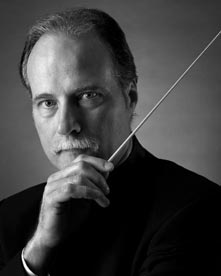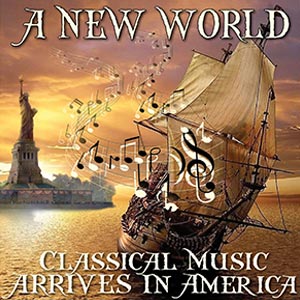Concert 4
A New World–Classical Music Arrives in America
February 28, 2019
George Eychner, trumpet, David Isadore, English horn
Haley Dove Montoya, soprano

Sponsored by Kerr County Abstract & Title
Sponsored by Re/Max Kerrville
Conductor’s Letter

Gene Dowdy
Conductor & Artistic Director
Dear Symphony of the Hills’ Friends,
Many have said that music provides us human beings with a common language to express all of our emotions. Henry Wadsworth Longfellow said “Music is the universal language of mankind.” In the late 19th century, Antonin Dvořák, the Czech master composer, was invited to a residency in the United States to lead a music conservatory. During his time in America, he admired Native American and African-American music. He said that he was influenced by their rhythms and sounds in composing his signature work, the Symphony No. 9 in E Minor, subtitled From the New World. Of course, before his arrival in America, Dvořák was well-known for his inclusion of Czech and Eastern European melodies and rhythms in his music.
We open the concert with two of American composer Aaron Copland’s best known works—his Hoedown from the ballet Rodeo, and his profound incidental music from the play Quiet City. As an homage to Dvořák’s urging of composers to recognize native music, we include a setting of two African-American spirituals in the program arranged by David Mairs, former resident conductor of the San Antonio Symphony. The program also includes one of Dvořák’s best known opera arias, the famous “Song to the Moon” from Rusalka, sung by local star soprano, Haley Dove Montoya.
One of the beautiful aspects of music, and indeed all the arts, is how they can represent cultural influences and inspiration in a timeless setting. Great art inspires us to greater things. Vive le’Arts!
As always, thank you for your support of great orchestral music in the Hill Country!
Gene Dowdy
Conductor & Artistic Director
Concert Notes
In light of the overwhelming influx of European immigrants to the US in the 18th – 20th century, it is entirely logical that the fundamental basis of American music came from European artistry. Such music is based on the 12-note scale which is said to have originated in Greece, spread to Europe over 3 – 4 millennia and was refined in the mid-19th century to the well-tempered standard we have today.
Through the middle of the 20th century, largely because of religious persecution, poverty and the economic hardship of war, European immigrants from the United Kingdom, Ireland, Spain, Germany, and France began arriving in large numbers, bringing with them the styles of music popular in their culture. Especially influential in the further development of uniquely American pops music genres were the Irish and the Germans. Many visited America to gain inspiration for their work, others came here and stayed (and served to inspire others, such as Copland.)
Hoe-down from Rodeo
Aaron Copland (1900 – 1990)
Aaron Copland–composer, composition teacher, writer, and later a conductor – was often referred to by his peers and critics as “the Dean of American Composers.” The changing harmonies in much of his music are typical of what many consider to be the sound of American music. Copland wrote a total of about 100 works which covered a vast range of genres. Many of these compositions, especially orchestral pieces, have remained part of the standard American repertoire.
In 1942 Copland composed the ballet Rodeo, a tale of a ranch wedding written about the same time as his Lincoln Portrait. Rodeo is another enduring composition by Copland and contains many recognizable folk tunes well-blended with Copland’s original music. Notable in the final ballet movement is the striking “Hoedown,” a recreation of Appalachian fiddler W. H. Stepp’s version of the tune “Bonypart” (“Bonaparte’s Retreat”). Stepp had transformed the tempo from a march to a hoedown and it made a strong impression on Copland, who subsequently incorporated it note for note in “Hoedown.” This piece is now one of the best-known compositions by any American composer, having been used countless times in movies and television. It can be added that the Rodeo ballet was choreographed by Agnes de Mille, niece of film giant Cecil B. DeMille. It premiered at the Metropolitan Opera in 1942, with de Mille dancing the principal “cowgirl” role; the performance understandably received a standing ovation.
Quiet City
Aaron Copland (1900–1990)
<<<George Eychner, trumpet; David Isadore, English horn>>>
Originally, Quiet City was a play written by Irwin Shaw, first performed in 1939. The play was apparently a real dud and closed after only three performances on Broadway. Despite the poor reception of the play, Aaron Copland’s music for it, later reworked by him into a ten-minute work of the same title, became a well-known composition for trumpet, alto sax, and string orchestra. Copland stated that the piece was supposed to reflect the substance of the play’s principle character.
African-American Spirituals
David Mairs, Arr.
Among the countless familiar and widely played Afro-American spirituals are “I Wonder as I Wander” attributed to John Jacob Niles in 1933, who was inspired to write it from music he heard in Appalachia some years earlier. The piece is typical spiritual or gospel song. Also, we will hear “Sometimes I Feel Like a Motherless Child” a Negro spiritual that dates from a period prior to the Civil War.
Song to the Moon from Rusalka
Antonín Leopold Dvořák (1841–1904)
<<<Haley Dove Montoya, soprano>>>
The Czech composer Dvořák (Da-vor’-zhock) was born in a small town near Prague. He was the second Czech composer to achieve major worldwide recognition after Smetana. He displayed his musical gifts early on, being an exceptional violin student from age six. Before age 10, Dvořák was taking organ, piano, and violin lessons from his German-language teacher, who also taught the youngster music theory and introduced him to composers of the time. Following this period of training and practice, Dvořák played viola for many years in Prague orchestras. He thus had direct experience with a wide range of operas by Mozart, Weber, Rossini, Verdi, Wagner and Smetana.
Rusalka was the ninth opera Dvořák composed and was one of the most successful Czech operas ever. It was first performed in Prague in 1901. A “rusalka,” for those insatiably curious readers who will otherwise Google the word, is a water sprite from Slavic mythology, usually inhabiting a lake or river. The most popular song from Rusalka is the “Song to the Moon” from act 1, an aria which is often performed in concert and recorded separately.
Rusalka the water sprite has fallen in love with a Prince (unfortunately not a water sprite) who comes to hunt at the lake. She wants to marry the Prince, but of course her father is not keen on the idea, since he hasn’t even met the Prince. He suggests that she see a witch for assistance, at which point she sings her “Song to the Moon,” asking that the Prince be informed of her love. The Prince is quite pleased to hear this; the two get married and run off together.
Concert Notes by Jim Adams
Symphony No. 9, New World Symphony
Antonín Leopold Dvořák (1841–1904)
Dvořák’s Ninth Symphony has remained one of the most popular works of the symphonic repertory ever since its sensational world premiere in New York City in 1893.
Dvořák’s early compositions were directly inspired by Czech, Moravian, Bohemian and other Slavic traditional music. He was passionate about his music, but his first composing efforts received no critical reception or public performance beyond the region around Prague, known as Bohemia. Seeking wider recognition, Dvořák submitted some of his early symphonic works to prize competitions in Germany. He was awarded the Austrian State Prize in 1874, 1876 and 1877, the jury for which was led by Johannes Brahms. Brahms was mightily impressed with Dvořák’s music and subsequently recommended Dvořák to his publisher, who soon afterward commissioned what became the Slavonic Dances, Op. 46.
At an invitation of the National Conservatory of Music in New York City, in 1892 Dvořák came to America as Director of that institution at the then-staggering annual salary of $15,000. He stated that his main goal in America was to discover “American Music” and engage in it, much as he had used Czech folk idioms within his music in Prague. Shortly after his arrival in America, Dvořák wrote a series of newspaper articles on the state of American music. He often expressed the idea that American classical music needed its own models instead of imitating European composers; he helped to inspire subsequent composers to develop a distinctly American style.
Through his leadership of the National Conservatory, Dvořák became familiar with St. Phillips, an African-American institution located near the Conservatory. He developed a friendship with Harry Burleigh, one of the black students from St. Phillips. Dvořák saw a reflection of himself in Burleigh, a struggling student, and employed Burleigh as Conservatory orchestra librarian and copyist. Dvořák was quoted in the New York Herald as saying, “In the negro melodies of America I discover all that is needed for a great and noble school of music.” It appears that African-American spirituals were a major influence on Dvořák’s American music, and indeed Harry Burleigh has been credited with giving Dvořák some of the thematic material for his 9th Symphony.
In the winter and spring of 1893, Dvořák was commissioned by the New York Philharmonic to write Symphony No.9, “From the New World”, which premiered to tumultuous applause. It is indeed a much loved and inspirational piece of music, a monumental work at once exhilarating and comforting. By far this is Dvořák’s most popular symphony, and one of the most popular of all symphonies. It is interesting to note that Astronaut Neil Armstrong took a tape recording of the New World Symphony along during the Apollo 11 mission, the first Moon landing, in 1969.
Concert Notes by Jim Adams



